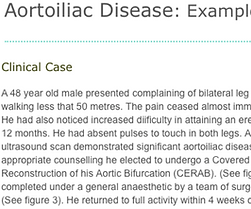
Conditions Treated
Aortoiliac Disease
(Leriche syndrome)

What symptoms are associated with aortoiliac disease?
This is classically described as affecting males who become aware of buttock and/or thigh pain when walking and erectile dysfuntion (impotence). This combination, when combined with the clinical examination finding of absent or weak groin pulses, is termed Leriche syndrome. However, individuals with aortoiliac disease may suffer with other ‘non-classical’ symptoms, including muscle wasting, delayed wound healing or limb-threatening ischaemia affecting the legs and/or buttocks.
What causes aortoiliac disease?
All symptoms are as a result of insufficient blood perfusing the legs and pelvic organs due to the arterial narrowing/blockage (See figure 1). This narrowing/blockage is typically the result of atherosclerotic (fatty) plaques that have built up over a period of years causing gradual narrowing of the arteries until eventually they block. Smoking, diabetes, high blood pressure and high cholesterol are all risk factors for aortoiliac disease.
How is aortoiliac disease investigated?
Investigation is centred around identifying the presence and extent of disease affecting the aortoiliac arterial segment. Typically this involves an ultrasound in the first instance to identify the presence of peripheral arterial disease. We will often combine this with a CT angiogram to better assess the extent and type of disease, as well as to allow accurate planning for any treatments.
How is aortoiliac disease treated?
The surgical treatment of aortoiliac disease involves improving blood flow into the legs by overcoming the narrowing or blockage affecting the aortoiliac arterial segment. This can be done either with open surgery (such as aortobifemoral bypass) or endovascular (minimally invasive) surgery (iliac artery angioplasty or CERAB - covered endovascular reconstruction of the aortic bifurcation).
Which surgical technique is best?
We are able to offer a full variety of techniques for the treatment of aortoiliac disease and are not constrained in our decision making. Each patient’s case is reviewed by our team of experts to ensure all options are properly analysed before we recommend a specific treatment. The technique we propose is dependent on many factors including the severity of symptoms, the extent of disease and your general health. We have no hesitation in recommending no invasive treatment when we believe surgery is not the appropriate option.
Search Symptoms and Conditions
What should I do next?
If you think you have this condition or any of the described symptoms we recommend you seek medical advice.
For further information or to arrange an appointment at Circulation Clinic
Enquiries: 0345 3690106

Fig.1: CT angiogram demonstrating an occluded Aortoiliac segment

